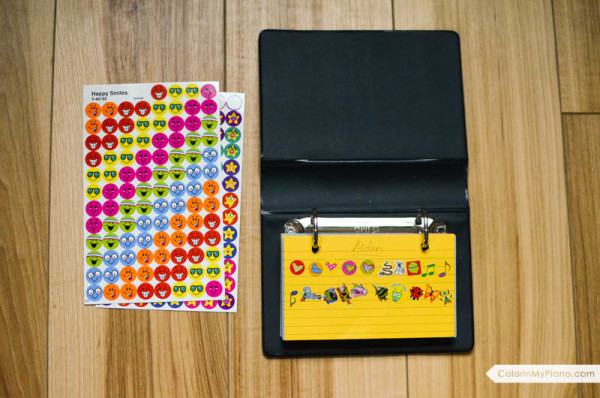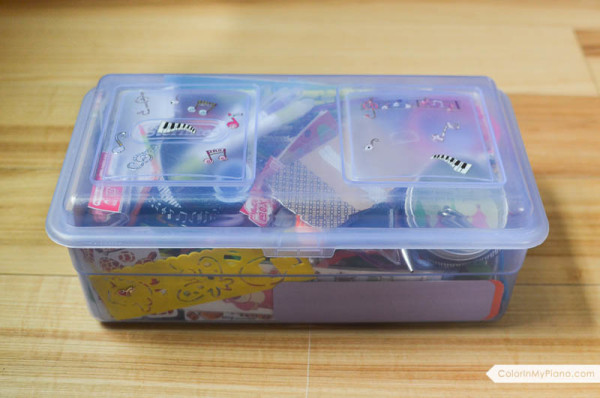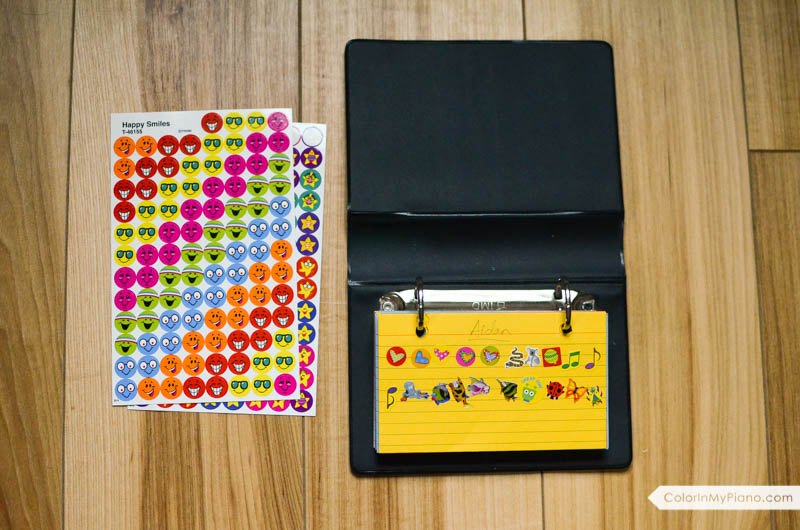Do you use an incentive program in your piano studio? Incentive programs can be a useful way to motivate and encourage students to be diligent and productive with their practicing. More importantly, an incentive program can help emphasize the behaviors or goals the teacher expects from the student. Below is information about how I designed an ongoing incentive program for my students.

Growing up, I recall my piano teacher implementing a number of different programs while I was taking lessons — unfortunately, she never stuck with one long enough for me to earn a prize very often. A good incentive program must be simple enough for the students to understand, and cannot be too time consuming as to take up a lot of the lesson time. It needs to be easily attainable, otherwise students will give up on ever earning a prize.
Most incentive programs are based on the number of minutes or days that the student practices. A weakness of this approach is that the older students might be more likely to win prizes more often than the younger students, which doesn’t seem very fair, especially since the younger students are the ones who can most easily be influenced through the use of an incentive program. In addition, this approach does not guarantee that the student practicing productively – that is, troubleshooting and solving problem areas, rather than mindlessly playing through their pieces.
For the above reasons, I designed my incentive program to be based on the number of pages of music they master. For example, if a student “passes” a three-page song from their Lesson Book, they earn three stickers. Each page completed form their theory book also earns them stickers. Stickers are also awarded for each page of music memorized, each page of counts written into the music (1…2…3…4…1…2…3…etc.), or any other task that I determine. No matter what the activity, it’s simply 1 page = 1 sticker.
I place the stickers onto index cards that have the students’ names written across the top. The index cards are organized in order of my schedule (Monday students, Tuesday students, etc.) so that it is easy to flip to the next student when they arrive for their lesson. The index cards can be stored in an index card box or in an index card binder (I bought mine at the dollar store and I use a hole puncher to create refill cards).

When a student earns 30 stickers (3 rows of 10 stickers) on their index card, they may choose a prize from the the prize box at the end of the lesson. I use small stickers that fit well onto the index cards. I also allow students to put a larger sticker directly in their books for the piece of music that is “passed.” Once an index card is filled, we start a new one.
My prize box is a clear purple, plastic shoebox decorated with music stickers. I regularly restock the prize box full of inexpensive trinkets – such as little notepads, colored pens (usually 2 or 3 rubberbanded together), bouncy balls, matchbox cars, keychains, animal puzzle erasers, trinkets from thepracticeshoppe.com, etc. (see here or here for photos of prize box items). I generally limit myself to spending a dollar or less per item. I often find items at the dollar store, the dollar section at Target, or in the party favor aisle.

I have been using this incentive program for over five years now. I have found it to work well because it encourages students to practice with their minds fully engaged, consciously working towards the goal of “passing” their pieces. It is flexible enough to work for both beginners as well as intermediate students. The goal of 30 stickers is easily attainable, even for the younger students. It is simple enough that it works ongoing throughout the year, with very little investment of time on the teacher’s part.
If you want to alter this incentive program to suit your advancing intermediate students, I would create a second prize box with different prizes: for example, $10 iTunes gift cards. If you feel it is too easy for your advanced students to earn 30 stickers, you could increase the goal to 40 or more.
Having this incentive program in place helps my students learn to have the same priorities as me: progress and expressive music making.
What kind of incentive program have you found to work for your studio?
Update: Years later, read about the small tweak I made to my incentive program that makes it EVEN EASIER to maintain! Check it out here.



A few years ago I did something similar. I used “composer bucks” – fake money printed with composers faces instead of presidents. I had certain things they could earn money for. I had bigger prizes as well as smaller prizes so they could save their money or spend it on smaller things as they earned it. I’m going to start up something like this again. Thanks for sharing your ideas and program.
I have a question, please. Do you keep those index cards or do you let the students keep them? I have few younger students and they keep forget things, and so I was wondering how you’d do it! Thank you so much for sharing your great ideas!
Oh by the way, target has great one dollar section that has many cute things, too!
I hang on to the index cards. You can store them in a recipe card box, or you can use a three-hole punch to keep them in a binder. I keep them in order of my teaching schedule each day. Once the student has filled up one side of the card, I use the back for the next prize. Once both sides are filled, I let the student keep the card or we throw it away. Good luck – I hope this works for you!
I reward with music money. It is just play money that I found online and printed out. I reward various things, but the “cost” for the student to buy the rewards are all different. I usually price bigger items higher and smaller items lower (even though they all cost about $1 or less at the dollar store!) and that way if they want something like sidewalk chalk, they really have to save and earn it. If they want to spend their music money right away though, there are a few smaller items they can get such as candy or small trace rulers or stickers. I also do an auction at group lessons every so often for something really big and that way students want to come to group lessons to see what they might get! Those are just ideas. It seems to be working so far!
I made a bonus card filled with 24 or 25 empty blank boxes. I bought a happy face stamper to use as my point system to fill those empty blank boxes. For each song they pass, I would give them a stamp. If they completed their theory homework, I would also give them a stamp for that because most students tend to forget they have “homework”.
My incentive box is known as a “treasure chest” to the students.I go through the clearance and the dollar section at Walmart and Target. I notice kids tend to love bubble wands. These bubble wands would only cost 97 cents at Walmart and they make huge bubbles. The kids look forward to those. Girls tend to love decorative erasers and pencils. For the boys, I filled them with Superheros puzzles, a pack of stickers, mini skateboards and yo yos. I also tend to find that activity books or coloring books work really well also. I never go wrong with these items that I find at Target and Walmart. Today, I went to Walmart and was browsing through the clearance section and picked up some Crayola color bubbles. Supposedly it is messy, but I’m sure the kids will love seeing purple bubbles. I know the parents probably won’t like it. But hey, if the kids love it, they deserve it. A little fun won’t hurt sometimes.
Hi Maria, I like the idea of using a stamp; it’s a little more cost effective than to always buy stickers. I know the kids like the stickers but we can always go back and forth between the two methods. Thanks for the idea:)
Do any of you have older students (beginners in high school)? I am trying to keep a high school student motivated who has been on and off with lessons for years, mostly due to family moves. I am really wanting to keep him interested and wanting to do well, but not do treat him like a “baby” either…any thoughts?
I think high schoolers would still like the music money; then after reaching a pre-determined amount they can “buy” a prize. It’s teaching them about working for something AND money sense (how much do I want to spend on a particular item.) For prizes for the older kids, I like Joy’s suggestion of an iTunes card (although I might make it less than $10 if that’s possible.) Or how about a $5 gift card to Target; a piece of sheet music, $5 gift card to a favorite local hangout — food, ice cream, etc. Hope something here’s been helpful for you:)
My “treasure box” incentive works very well for all student ages – even my teen-age and adult students. I started with a variety of items and trinkets, but soon found out my students mostly wanted candy. So, that is what I mainly stock with the exception of a few students that arent’s into sweets (both of them like small office supplies). Part of my initial interview question is “What would you like to find in the treasure box?” To earn a “trip to the treasure box” my students must complete 15 practice sessions. They keep track of their practices on their weekly Practice Record (which I print off for each lesson which also shows their next lesson date and their cirriculum for the week, personal goals and self-assessment check-list) and then I note their practice totals each week on their Practice Record. Each student knows they must bring their weekly Practice Record sheet so I can keep adding up the total. (When they have 15 practice points at their lesson, I starting putting a zero, but now I make it into a “donut with sprinkles”). Beginning students are asked to practice at least 5 days per week, so they can earn a trip to the Treasure Box every 3 weeks. I add “extra points” for excellent lessons and if they have improved in a particulare skill. I also add points for additional research tasks or playing for talent shows, at church or for grand-parents visiting from out-of-town. I have found the extra points incentive has worked very well for students b/c they are thrilled to earn “extra practice points” as a way to get to the treasure box faster. It is a great self-motiivator b/c most of my students will end a lesson by saying, “Okay, so I need to practice ____ more time before I can go to the treasure box!” Or, “I get to go to the treasure box today.!” It is a great incentive for consistent practice and to be able to reward students for excellent lessons and additional “extra credit” work done well.
I love the note card with stickers on it for its portability . My trouble with a consistent incentive program has been traveling to multiple studios and not having my sticker chart up on the wall!
Debra, I love the “extra credit” points idea but do you tell all the students in advance how they can earn points or week by week determine those things?
Joy, your blog has been a great help to me as I became a full time private teacher this past year!
Yes, notecards are pretty portable! I also like that notecards allow it to easily be an ongoing thing. Once a few students reach the end of a sticker chart, you have to put up a new one on the wall.
Thanks for your comment, Belita!
Hi Joy,
Just a quick question, how long does it take a “good” student to earn a prize? I use sticker system as well. I reward them with a sticker if they completed their homework and had a productive practice. They have to earn 5 stickers to get a prize. So every 5 weeks more than half of my kids get a prize and I feel like it’s getting expensive. I have been thinking about increasing the number to 10. I just wander how many weeks does it usually take for your better students to earn a prize? Thanks
Hi Marina, It depends on the student, but I’d say it takes at least a couple of months for students to earn 30 stickers for a prize.
Is each sticker worth 1 point? Meaning 30 sticker=30 points=prize?
Correct, Stephanie!
A number of good tips here. I have used the same rewards program for 2 years straight, and according to research, I need to change it because programs get “stale” and participants are not enthused about them after a period of time. For short term rewards I do “Mega-Sticker” competitions, for example, I found an amazing, large pirate sticker, and several smaller pirate stickers, and held a pirate composition contest. Other events: Earth Day, Valentines Days, dinosaur, space, etc. I also record their compositions and post them to my private Youtube channel (usually unlisted viewing). The 2 yr program: I awarded points on their assignment sheet, say 20 points for completing all rep, 10 for theory, 10 for technique, 10 for bringing materials, 10 for practicing.. Then I awarded other points for misc. subjective values – posture, attitude, extra accomplishments, memorization, etc. I also deduct points – which they handle very well. If anyone’s bummed out about low points, I always give them an extra assignment to earn more points, and they always rise to the occasion! Points are accumulated twice/yr for a really good award, usually from an educational store. Expensive, but it did motivate them to practice. If I did it again, I would include the “awards” cost in my registration fee. A number of parents rewarded me with a gift card. Just be sure parents know to hold on to their assignment sheets – I provide each student with a binder with folders inside it for old assignment sheets, special assignments, etc. They love going through them at the end of the year to see everything they accomplished – and that’s a good way to give them an informal evaluation.
All great ideas, Carol!
i use a very similar system. One song = one sticker. After 30 stickers, they get a candy prize. One hour of practice = one star. After 10 stars, they get into the treasure box. It has dual incentive! It has worked well for me.
Joy,
I love your program for rewarding students. As a guitar teacher for the last 20 years I was finding it hard to push some of my younger students to push themselves when it came to practicing on their own. I started buying cool guitar picks at the store and offering these as prizes, these were the best incentives that the kids could want. I might try some of your sticker programs for my younger players though, it seems to work.
Thanks,
Dave W
Hi Dave, Guitar picks are THE perfect prize! I bet students like collecting different colors and designs. I wish there was an equivalent accessory for the piano. 🙂
Love the index card idea! I have always given monthly calendars to my students that they put in their binders and parents have to initial their practices in order to earn a prize. I also started aMusical Memory Club to encourage memorization and it was a hit! Students earns a Coldstone gift card for every 10 songs they memorized. I kept a log and the kids loved checking g each week to see how close they were to their next goal. Also created a fun poster with stars that went up each time someone achieved their next goal. The record after one year of this was 44 songs. And what a great resource it was for picking recital pieces and sharing on progress reports!
Guitar picks are great for kids Joy, the great thing about it now is online you can find a guitar pick to match almost anything a kid likes, Minecraft, Star Wars, etc.
I have also found that earning fake music money to buy prizes to be an affective motivator for my students. This year along with this idea we traveled along a Musikopoly board (an idea from another website, can’t remember which) so that by the end of the year they could earn a “Musikopoly Master” t-shirt if they made it to the end of the board, all the while earning little prizes along the way. Wish I could post a pic here but they turned out so cool for all ages. (T-shirts were designed on customink.com) So thankful for all the great ideas, Joy!! I’m a better teacher because of you!:)
That sounds so fun, Becky! It sounds like your students really enjoyed your incentive program this year!! 🙂
Wow, I did the same thing 2 years ago – Musicopoly Winner t-shirts from customink, probably got the idea from the same website and my students loved going around the Musicopoly board, earning rewards at each corner. Now seeing this blog and comments I’m getting some great ideas for this year. Thanks, everyone, for the inspiring ideas!